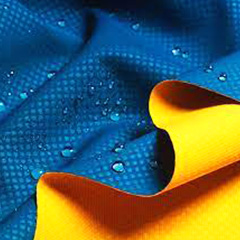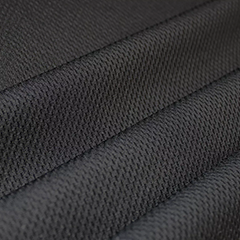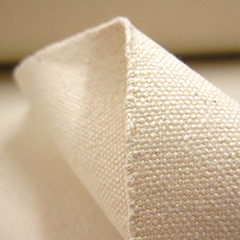High Performance Laser Cut Waterproof UV Resistant Fabric
Laser Cut Waterproof UV Resistant Fabric combines precision engineering with advanced material performance. The laser cutting process ensures clean, sealed edges that prevent fraying, while the fabric's waterproof and UV-resistant properties make it ideal for outdoor and industrial applications. Whether used in tents, awnings, protective covers, or technical gear, this fabric offers long-lasting durability, weather protection, and a sleek, professional finish.
▶ The Basic Introduction Of Waterproof UV Resistant Fabric
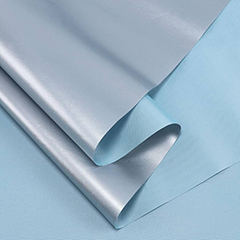
Waterproof UV Resistant Fabric
Waterproof UV resistant fabric is specially designed to withstand moisture and prolonged sun exposure.
It prevents water penetration while blocking harmful ultraviolet (UV) rays, making it ideal for outdoor applications such as tents, awnings, covers, and apparel. This fabric offers durability, weather resistance, and protection in various environments, ensuring long-lasting performance in both rain and sunlight.
▶ Material Properties Analysis of Waterproof UV Resistant Fabric
This fabric combines water repellency and UV protection, using coated surfaces or treated fibers to block moisture and resist sun damage. It is durable, weather-resistant, and suitable for long-term outdoor use.
Fiber Composition & Types
Waterproof and UV-resistant fabrics can be made from natural, synthetic, or blended fibers. However, synthetic fibers are most commonly used due to their inherent properties.
PVC-Coated Polyester
Composition: Polyester base + PVC coating
Features: 100% waterproof, durable, heavy-duty
Applications: Tarpaulins, rainwear, industrial covers
PU-Coated Nylon or Polyester
Composition: Nylon or polyester + polyurethane coating
Features: Waterproof, lightweight, breathable (depending on thickness)
Applications: Tents, jackets, backpacks
Solution-Dyed Acrylic
Composition: Acrylic fiber dyed before spinning
Features: Excellent UV resistance, mildew-resistant, breathable
Applications: Outdoor cushions, awnings, boat covers
PTFE-Laminated Fabrics (e.g., GORE-TEX®)
Composition: Membrane of PTFE laminated to nylon or polyester
Features: Waterproof, windproof, breathable
Applications: High-performance outerwear, hiking gear
Ripstop Nylon or Polyester
Composition: Reinforced woven nylon/polyester with coatings
Features: Tear-resistant, often treated with DWR (durable water repellent)
Applications: Parachutes, outdoor jackets, tents
Vinyl (PVC) Fabric
Composition: Woven polyester or cotton with vinyl coating
Features: Waterproof, UV and mildew-resistant, easy to clean
Applications: Upholstery, awnings, marine applications
Mechanical & Performance Properties
| Property | Description | Function |
|---|---|---|
| Tensile Strength | Resistance to breaking under tension | Indicates durability |
| Tear Strength | Resistance to tearing after puncture | Important for tents, tarps |
| Abrasion Resistance | Withstands surface wear | Extends fabric lifespan |
| Flexibility | Bends without cracking | Enables folding and comfort |
| Elongation | Stretches without breaking | Improves adaptability |
| UV Resistance | Withstands sun exposure | Prevents fading and aging |
| Waterproofness | Blocks water penetration | Essential for rain protection |
Structural Characteristics
Advantages & Limitations
Waterproof and UV-resistant fabrics are designed with durable weaves (like ripstop), high fiber density, and protective coatings (PU, PVC, or PTFE). They may be single or multi-layered, and often treated with DWR or UV stabilizers to enhance water and sun resistance. Fabric weight also affects durability and breathability.
Cons:
Poor breathability (e.g., PVC), less flexible, may not be eco-friendly, higher cost for premium types, some (like nylon) need UV treatment.
Pros:
Waterproof, UV-resistant, durable, mildew-resistant, easy to clean, some are lightweight.
▶ Applications of Waterproof UV Resistant Fabric
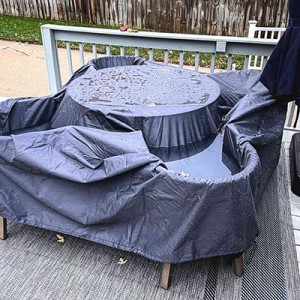
Outdoor Furniture Covers
Protects patio furniture from rain and sun damage.
Extends the life of cushions and upholstery.
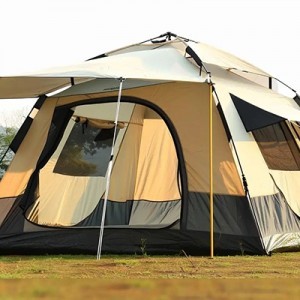
Tents and Camping Gear
Ensures tents remain dry inside during rain.
UV resistance prevents fabric from fading or weakening due to sun exposure.
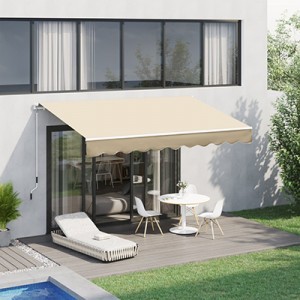
Awnings and Canopies
Used in retractable or fixed awnings to provide shade and shelter.
UV resistance maintains color and fabric strength over time.
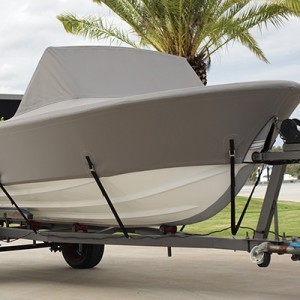
Marine Applications
Boat covers, sails, and upholstery benefit from waterproof and UV-resistant fabrics.
Protects against saltwater corrosion and sun bleaching.
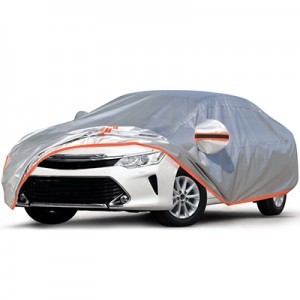
Car Covers and Vehicle Protection
Shields vehicles from rain, dust, and UV rays.
Prevents paint fading and surface damage.
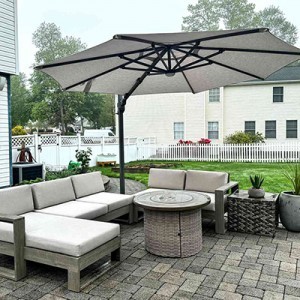
Umbrellas and Parasols
Provides effective rain and sun protection.
UV resistance prevents fabric from degrading in sunlight.
▶ Comparison with Other Fibers
| Feature | Waterproof UV Resistant Fabric | Cotton | Polyester | Nylon |
|---|---|---|---|---|
| Water Resistance | Excellent — usually coated or laminated | Poor — absorbs water | Moderate — some water repellency | Moderate — can be treated |
| UV Resistance | High — specially treated to resist UV | Low — fades and weakens under sun | Moderate — better than cotton | Moderate — UV treatments available |
| Durability | Very high — tough and long-lasting | Moderate — prone to wear and tear | High — strong and abrasion resistant | High — strong and durable |
| Breathability | Variable — waterproof coatings reduce breathability | High — natural fiber, very breathable | Moderate — synthetic, less breathable | Moderate — synthetic, less breathable |
| Maintenance | Easy to clean, quick drying | Requires careful washing | Easy to clean | Easy to clean |
| Typical Applications | Outdoor gear, marine, awnings, covers | Casual wear, home textiles | Activewear, bags, upholstery | Outdoor gear, parachutes |
▶ Recommended Laser Machine for Waterproof UV Resistant Fabric
We Tailor Customized Laser Solutions for Production
Your Requirements = Our Specifications
▶ Laser Cutting Waterproof UV Resistant Fabric Steps
Step One
Setup
Clean and lay the fabric flat; secure it to prevent movement.
Choose proper laser power and speed
Step Two
Cutting
un the laser with your design; monitor the process.
Step Three
Finish
se heat sealing if needed to enhance waterproofing.
Confirm correct size, clean edges, and maintained properties.
Learn More Information about Laser Cutters & Options
▶ Waterproof UV Resistant Fabric's FAQs
UV resistant fabrics include both synthetic and treated natural materials that block harmful ultraviolet rays. Synthetic fabrics like polyester, acrylic, olefin, and solution-dyed materials (e.g., Sunbrella®) offer excellent UV resistance due to their tight weave and durable fiber composition.
Nylon also performs well when treated. Natural fabrics such as cotton and linen are not naturally UV resistant but can be chemically treated to improve their protection. UV resistance depends on factors like weave density, color, thickness, and surface treatments. These fabrics are widely used in outdoor clothing, furniture, tents, and shade structures for long-lasting sun protection.
To make fabric UV resistant, manufacturers or users can apply chemical UV-blocking treatments or sprays that absorb or reflect ultraviolet rays. Using tightly woven or thicker fabrics, dark or solution-dyed colors, and blending with inherently UV-resistant fibers like polyester or acrylic also enhances protection.
Adding UV-blocking liners is another effective method, especially for curtains or awnings. While these treatments can significantly improve UV resistance, they may wear off over time and require reapplication. For reliable protection, look for fabrics with certified UPF (Ultraviolet Protection Factor) ratings.
To waterproof fabric for outdoor use, apply waterproofing spray, wax coating, or liquid sealant depending on the material. For stronger protection, use heat-sealed vinyl or laminated waterproof layers. Always clean the fabric first and test on a small area before full application.
The best UV resistant fabric is typically solution-dyed acrylic, such as Sunbrella®. It offers:
-
Excellent UV resistance (built into the fiber, not just surface)
-
Fade-proof color even after prolonged sun exposure
-
Durability in outdoor conditions (mold, mildew, and water resistant)
-
Soft texture, suitable for furniture, awnings, and clothing
Other strong UV-resistant fabrics include:
-
Polyester (especially with UV treatments)
-
Olefin (Polypropylene) – highly resistant to sunlight and moisture
-
Acrylic blends – for balance of softness and performance





